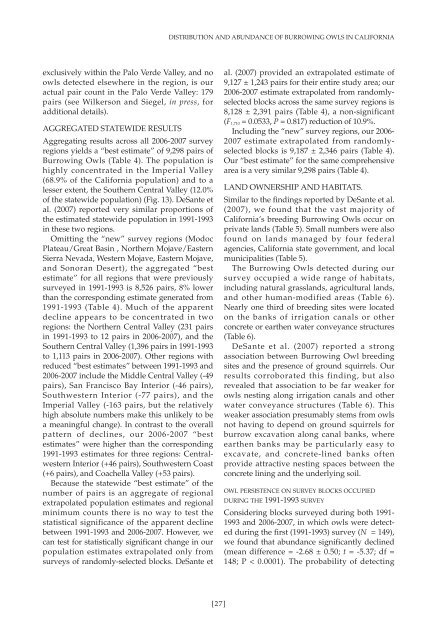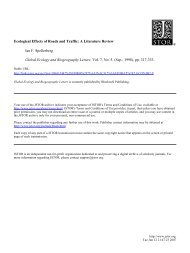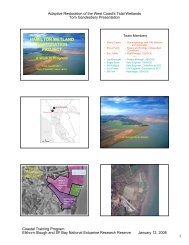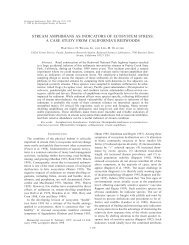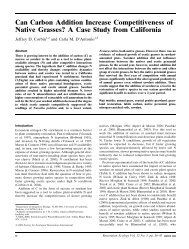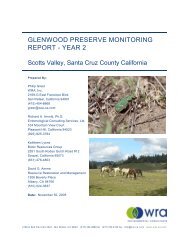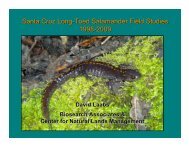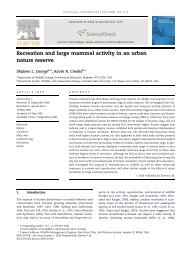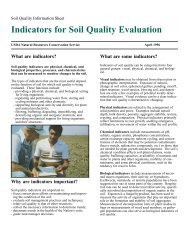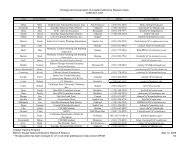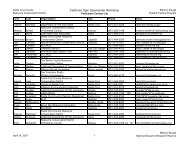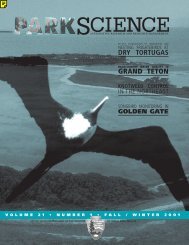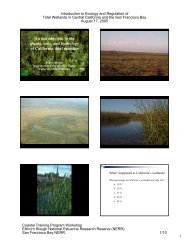BIRD POPULATIONS - Birdpop.org
BIRD POPULATIONS - Birdpop.org
BIRD POPULATIONS - Birdpop.org
- No tags were found...
You also want an ePaper? Increase the reach of your titles
YUMPU automatically turns print PDFs into web optimized ePapers that Google loves.
DISTRIBUTION AND ABUNDANCE OF BURROWING OWLS IN CALIFORNIAexclusively within the Palo Verde Valley, and noowls detected elsewhere in the region, is ouractual pair count in the Palo Verde Valley: 179pairs (see Wilkerson and Siegel, in press, foradditional details).AGGREGATED STATEWIDE RESULTSAggregating results across all 2006-2007 surveyregions yields a “best estimate” of 9,298 pairs ofBurrowing Owls (Table 4). The population ishighly concentrated in the Imperial Valley(68.9% of the California population) and to alesser extent, the Southern Central Valley (12.0%of the statewide population) (Fig. 13). DeSante etal. (2007) reported very similar proportions ofthe estimated statewide population in 1991-1993in these two regions.Omitting the “new” survey regions (ModocPlateau/Great Basin , Northern Mojave/EasternSierra Nevada, Western Mojave, Eastern Mojave,and Sonoran Desert), the aggregated “bestestimate” for all regions that were previouslysurveyed in 1991-1993 is 8,526 pairs, 8% lowerthan the corresponding estimate generated from1991-1993 (Table 4). Much of the apparentdecline appears to be concentrated in tworegions: the Northern Central Valley (231 pairsin 1991-1993 to 12 pairs in 2006-2007), and theSouthern Central Valley (1,396 pairs in 1991-1993to 1,113 pairs in 2006-2007). Other regions withreduced “best estimates” between 1991-1993 and2006-2007 include the Middle Central Valley (-49pairs), San Francisco Bay Interior (-46 pairs),Southwestern Interior (-77 pairs), and theImperial Valley (-163 pairs, but the relativelyhigh absolute numbers make this unlikely to bea meaningful change). In contrast to the overallpattern of declines, our 2006-2007 “bestestimates” were higher than the corresponding1991-1993 estimates for three regions: CentralwesternInterior (+46 pairs), Southwestern Coast(+6 pairs), and Coachella Valley (+53 pairs).Because the statewide “best estimate” of thenumber of pairs is an aggregate of regionalextrapolated population estimates and regionalminimum counts there is no way to test thestatistical significance of the apparent declinebetween 1991-1993 and 2006-2007. However, wecan test for statistically significant change in ourpopulation estimates extrapolated only fromsurveys of randomly-selected blocks. DeSante etal. (2007) provided an extrapolated estimate of9,127 ± 1,243 pairs for their entire study area; our2006-2007 estimate extrapolated from randomlyselectedblocks across the same survey regions is8,128 ± 2,391 pairs (Table 4), a non-significant(F 1,710 = 0.0533, P = 0.817) reduction of 10.9%.Including the “new” survey regions, our 2006-2007 estimate extrapolated from randomlyselectedblocks is 9,187 ± 2,346 pairs (Table 4).Our “best estimate” for the same comprehensivearea is a very similar 9,298 pairs (Table 4).LAND OWNERSHIP AND HABITATS.Similar to the findings reported by DeSante et al.(2007), we found that the vast majority ofCalifornia’s breeding Burrowing Owls occur onprivate lands (Table 5). Small numbers were alsofound on lands managed by four federalagencies, California state government, and localmunicipalities (Table 5).The Burrowing Owls detected during oursurvey occupied a wide range of habitats,including natural grasslands, agricultural lands,and other human-modified areas (Table 6).Nearly one third of breeding sites were locatedon the banks of irrigation canals or otherconcrete or earthen water conveyance structures(Table 6).DeSante et al. (2007) reported a strongassociation between Burrowing Owl breedingsites and the presence of ground squirrels. Ourresults corroborated this finding, but alsorevealed that association to be far weaker forowls nesting along irrigation canals and otherwater conveyance structures (Table 6). Thisweaker association presumably stems from owlsnot having to depend on ground squirrels forburrow excavation along canal banks, whereearthen banks may be particularly easy toexcavate, and concrete-lined banks oftenprovide attractive nesting spaces between theconcrete lining and the underlying soil.OWL PERSISTENCE ON SURVEY BLOCKS OCCUPIEDDURING THE 1991-1993 SURVEYConsidering blocks surveyed during both 1991-1993 and 2006-2007, in which owls were detectedduring the first (1991-1993) survey (N = 149),we found that abundance significantly declined(mean difference = -2.68 ± 0.50; t = -5.37; df =148; P < 0.0001). The probability of detecting[27]


